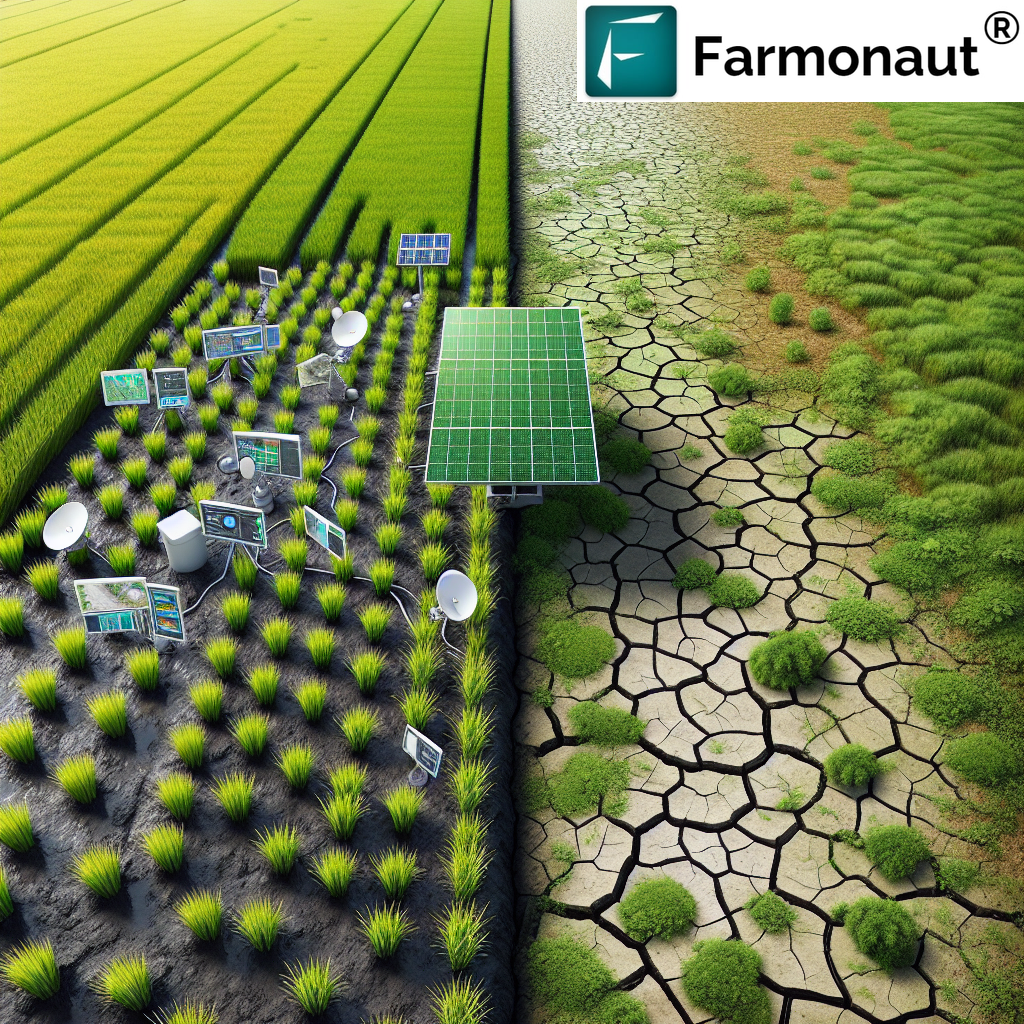Drought in India 2023: Impact on Agriculture and Rice Production

As we delve into the critical issue of drought in India 2023, it’s essential to understand its far-reaching implications on the country’s agricultural sector, particularly rice production. At Farmonaut, we recognize the importance of addressing these challenges and providing innovative solutions to support farmers and ensure food security.
Understanding the Severity of Drought India 2023
The drought in India 2023 has emerged as a significant concern for the agricultural sector, affecting various regions across the country. As a leading agricultural technology company, we at Farmonaut have been closely monitoring this situation through our advanced satellite-based farm management solutions.
Key factors contributing to the severity of the drought include:
- Delayed monsoon onset
- Uneven rainfall distribution
- Higher-than-normal temperatures
- Depleting groundwater levels
These factors have collectively led to water scarcity, impacting crop growth and yields across various states. Our satellite imagery analysis reveals the extent of the drought’s impact on vegetation health, soil moisture levels, and overall crop conditions.
Impact on India Agriculture Production 2023
The India agriculture production 2023 has been significantly affected by the ongoing drought conditions. Our data-driven insights indicate that several key crops have experienced reduced yields and quality due to water stress and unfavorable growing conditions.
Some of the major impacts observed include:
- Reduced crop acreage in rain-fed areas
- Stunted growth and lower biomass accumulation
- Increased pest and disease incidence due to plant stress
- Early harvest of some crops to minimize losses
- Shift in cropping patterns towards more drought-tolerant varieties
At Farmonaut, we’ve been utilizing our Jeevn AI Advisory System to provide farmers with real-time insights and personalized recommendations to mitigate the impact of drought on their crops. This AI-driven tool analyzes satellite data, weather forecasts, and other critical parameters to generate customized advice for optimal crop management under challenging conditions.
Focus on Rice Production in India 2023

One of the most significant concerns arising from the drought is its impact on rice production in India 2023. Rice, being a water-intensive crop, is particularly vulnerable to drought conditions. Our satellite-based crop health monitoring system has revealed alarming trends in major rice-producing regions:
- Reduced paddy transplantation area in states like Punjab, Haryana, and Uttar Pradesh
- Delayed sowing and transplanting activities due to insufficient rainfall
- Lower plant density and reduced tillering in affected areas
- Increased reliance on groundwater for irrigation, leading to rapid depletion of aquifers
These factors collectively pose a significant threat to India’s rice production targets for 2023. As a response to these challenges, we at Farmonaut have been working closely with farmers, agricultural institutions, and government bodies to implement drought mitigation strategies and optimize rice cultivation practices.
Farmonaut’s Role in Mitigating Drought Impact
At Farmonaut, we’re committed to leveraging our cutting-edge technologies to help farmers and stakeholders navigate the challenges posed by the drought in India 2023. Our comprehensive suite of tools and services plays a crucial role in drought mitigation and agricultural resilience:
1. Satellite-Based Crop Health Monitoring
Our advanced satellite imagery analysis provides real-time insights into crop health, allowing farmers to identify areas of stress and take timely corrective actions. This technology is particularly valuable during drought conditions, as it helps in:
- Early detection of water stress in crops
- Identifying areas requiring immediate irrigation
- Monitoring the effectiveness of drought-mitigation measures
- Assessing crop damage for insurance and relief purposes
To access our satellite-based crop monitoring services, visit Farmonaut Crop Monitoring.
2. AI-Powered Advisory System
Our Jeevn AI Advisory System provides personalized recommendations to farmers based on real-time data analysis. During drought conditions, this system offers:
- Customized irrigation schedules to optimize water usage
- Recommendations for drought-tolerant crop varieties
- Advice on soil moisture conservation techniques
- Early warnings for potential pest and disease outbreaks
3. Weather Forecasting and Climate Analytics
Accurate weather forecasting is crucial for agricultural planning, especially during drought periods. Our weather API provides:
- High-resolution, location-specific weather forecasts
- Long-term climate trends and drought predictions
- Alerts for extreme weather events
Developers and businesses can integrate our weather data into their systems through our Farmonaut API.
4. Resource Management Tools
Efficient resource management is critical during drought periods. Our platform offers:
- Water budgeting tools for optimal irrigation planning
- Soil moisture monitoring to prevent over-irrigation
- Crop water requirement calculations based on growth stage and weather conditions
5. Blockchain-Based Traceability
Our blockchain technology ensures transparency in agricultural supply chains, which is particularly important during drought-induced scarcity. This system:
- Tracks the origin and journey of agricultural products
- Helps in fair price determination based on quality and production conditions
- Supports efficient distribution of drought-affected produce
Comparison: Farmonaut Satellite System vs. Drone and IoT-based Farm Monitoring
| Feature | Farmonaut Satellite System | Drone-based Monitoring | IoT-based Monitoring |
|---|---|---|---|
| Coverage Area | Large scale (Regional to Global) | Limited (Local) | Limited (Field-specific) |
| Frequency of Data Collection | Regular (Every few days) | On-demand | Continuous |
| Initial Setup Cost | Low | High | Medium to High |
| Operational Complexity | Low | High | Medium |
| Weather Dependency | Low | High | Low |
| Data Processing Time | Fast | Medium | Real-time |
| Scalability | Highly Scalable | Limited Scalability | Moderately Scalable |
Strategies for Drought Resilience in Agriculture
As we navigate the challenges posed by the drought in India 2023, it’s crucial to implement comprehensive strategies for building drought resilience in agriculture. At Farmonaut, we recommend the following approaches:
1. Water-Efficient Irrigation Techniques
Adopting water-efficient irrigation methods is paramount in conserving water resources during drought periods. Some effective techniques include:
- Drip irrigation: Delivers water directly to plant roots, minimizing evaporation losses
- Sprinkler irrigation: Provides uniform water distribution and can be automated for optimal timing
- Subsurface drip irrigation: Reduces water loss through evaporation and improves nutrient uptake
Our satellite-based monitoring system helps farmers identify areas that require irrigation, ensuring targeted and efficient water application.
2. Crop Diversification and Drought-Tolerant Varieties
Diversifying crop portfolios and introducing drought-tolerant varieties can significantly enhance farm resilience. We recommend:
- Planting a mix of crops with varying water requirements
- Introducing drought-tolerant rice varieties developed by agricultural research institutions
- Exploring alternative crops that are better suited to water-scarce conditions
Our AI advisory system provides personalized recommendations for crop selection based on local conditions and drought forecasts.
3. Soil Health Management
Maintaining soil health is crucial for improving water retention and crop resilience. Key practices include:
- Incorporating organic matter to improve soil structure and water-holding capacity
- Implementing conservation tillage to reduce soil moisture loss
- Using mulching techniques to conserve soil moisture and suppress weed growth
Our satellite imagery analysis helps farmers monitor soil health indicators and make informed decisions on soil management practices.
4. Weather-Based Crop Planning
Aligning crop planning with weather forecasts can help mitigate drought risks. Our weather API and climate analytics tools support:
- Adjusting sowing dates based on rainfall predictions
- Planning for supplementary irrigation during critical growth stages
- Implementing contingency plans for prolonged dry spells
5. Precision Agriculture Techniques
Leveraging precision agriculture technologies can optimize resource use and improve crop resilience. Farmonaut’s platform enables:
- Variable rate irrigation based on soil moisture maps
- Site-specific nutrient management to enhance plant vigor
- Early pest and disease detection for timely interventions
Government Initiatives and Policy Support
Addressing the drought in India 2023 requires concerted efforts from both the public and private sectors. Several government initiatives and policies have been implemented to support farmers and mitigate drought impacts:
1. Pradhan Mantri Krishi Sinchayee Yojana (PMKSY)
This flagship program aims to expand irrigation coverage and improve water use efficiency. Key components include:
- Accelerated Irrigation Benefit Programme (AIBP) for major and medium irrigation projects
- Har Khet Ko Pani for minor irrigation and rainwater harvesting
- Per Drop More Crop initiative promoting micro-irrigation technologies
At Farmonaut, we’re working with government agencies to provide satellite-based monitoring and assessment of these irrigation projects, ensuring their effectiveness in drought-prone areas.
2. National Food Security Mission (NFSM)
This mission focuses on increasing production of rice, wheat, pulses, and coarse cereals. In response to the drought, the mission has intensified efforts to:
- Promote drought-tolerant crop varieties
- Provide subsidies for micro-irrigation systems
- Support the distribution of seed minikits to affected farmers
Our AI advisory system complements these efforts by providing farmers with personalized crop management recommendations tailored to drought conditions.
3. Mahatma Gandhi National Rural Employment Guarantee Act (MGNREGA)
This program has been instrumental in creating drought-resilient infrastructure in rural areas. Key initiatives include:
- Construction of water conservation structures
- Land development and soil conservation works
- Renovation of traditional water bodies
Farmonaut’s satellite imagery analysis helps in identifying suitable locations for these projects and monitoring their impact on local water resources.
4. Crop Insurance Schemes
The government has strengthened crop insurance programs to protect farmers against drought-related losses. Key features include:
- Pradhan Mantri Fasal Bima Yojana (PMFBY) for comprehensive crop insurance
- Weather-based Crop Insurance Scheme (WBCIS) for protection against specific weather events
Our satellite-based crop health monitoring system provides valuable data for accurate loss assessment and timely claim settlements.
The Road Ahead: Sustainable Agriculture in a Changing Climate
As we confront the challenges posed by the drought in India 2023, it’s clear that building long-term resilience in agriculture is crucial. At Farmonaut, we believe that the future of sustainable agriculture lies in the integration of advanced technologies, traditional knowledge, and adaptive farming practices.
1. Climate-Smart Agriculture
Promoting climate-smart agricultural practices is essential for long-term sustainability. This approach includes:
- Developing and adopting climate-resilient crop varieties
- Implementing agroforestry systems to improve soil health and water retention
- Enhancing carbon sequestration through conservation agriculture techniques
Our carbon footprinting tools help farmers and agribusinesses monitor and reduce their environmental impact, aligning with global sustainability goals.
2. Digital Agriculture and Data-Driven Decision Making
The future of agriculture lies in leveraging digital technologies and big data analytics. Farmonaut is at the forefront of this revolution, offering:
- AI-powered crop monitoring and yield prediction models
- Blockchain-based traceability for transparent and efficient supply chains
- Integration of satellite data with ground-level sensors for comprehensive farm monitoring
To experience the power of digital agriculture, download our mobile app:
3. Water Resource Management and Conservation
Efficient water management is crucial for sustainable agriculture, especially in drought-prone regions. Future initiatives should focus on:
- Implementing large-scale rainwater harvesting and groundwater recharge projects
- Promoting wastewater recycling and reuse in agriculture
- Developing drought-resistant cropping systems and water-efficient farming practices
Our satellite-based monitoring tools provide valuable insights for water resource planning and management at both farm and regional levels.
4. Strengthening Agricultural Research and Extension Services
Continuous innovation and knowledge dissemination are essential for building resilience in agriculture. This involves:
- Intensifying research on drought-tolerant crop varieties and farming systems
- Enhancing farmer education and training programs on climate-smart agriculture
- Strengthening the linkages between research institutions, extension services, and farmers
Farmonaut collaborates with agricultural research institutions to integrate cutting-edge scientific knowledge into our advisory systems, ensuring that farmers have access to the latest innovations in drought management.
5. Policy Support and Institutional Frameworks
Creating an enabling environment for sustainable agriculture requires robust policy support and institutional frameworks. Key areas of focus include:
- Developing comprehensive drought management plans at national and state levels
- Implementing policies to promote sustainable water use and conservation in agriculture
- Strengthening agricultural credit and insurance systems to enhance farmers’ financial resilience
Our data-driven insights support policymakers in making informed decisions and assessing the impact of agricultural policies and programs.
Conclusion
The drought in India 2023 has underscored the urgent need for innovative solutions and collaborative efforts to build resilience in the agricultural sector. At Farmonaut, we remain committed to empowering farmers, agribusinesses, and policymakers with cutting-edge technologies and data-driven insights to navigate these challenges.
By leveraging satellite technology, artificial intelligence, and blockchain, we’re not only helping to mitigate the immediate impacts of drought but also paving the way for a more sustainable and resilient agricultural future. Our comprehensive suite of tools, from crop health monitoring to AI-powered advisory systems, is designed to support farmers at every step of their journey towards drought-resilient and sustainable farming practices.
As we look to the future, it’s clear that addressing the challenges of climate change and water scarcity will require ongoing innovation, collaboration, and commitment from all stakeholders in the agricultural ecosystem. At Farmonaut, we’re proud to be at the forefront of this transformation, driving positive change in Indian agriculture and beyond.
Together, we can build a more resilient, productive, and sustainable agricultural sector that can withstand the challenges of drought and ensure food security for generations to come.
FAQs
-
Q: How severe is the drought in India 2023?
A: The drought in India 2023 is significant, affecting multiple states and impacting major crops, especially rice production. Delayed monsoons, uneven rainfall distribution, and higher temperatures have contributed to its severity. -
Q: How has the drought affected India’s agriculture production in 2023?
A: The drought has led to reduced crop acreage, stunted growth, increased pest incidence, and shifts in cropping patterns. Rice production, in particular, has been significantly impacted due to its high water requirements. -
Q: What measures are being taken to mitigate the impact of drought on agriculture?
A: Measures include promoting water-efficient irrigation techniques, introducing drought-tolerant crop varieties, implementing soil health management practices, and leveraging technologies like Farmonaut’s satellite-based monitoring systems for precise farm management. -
Q: How can farmers access Farmonaut’s services to help manage drought conditions?
A: Farmers can access Farmonaut’s services through our mobile apps available on both Android and iOS platforms, or through our web interface. Our services include satellite-based crop monitoring, AI-powered advisory systems, and weather forecasting tools. -
Q: What government initiatives are in place to support farmers during drought conditions?
A: Key initiatives include the Pradhan Mantri Krishi Sinchayee Yojana for irrigation improvement, the National Food Security Mission for promoting drought-tolerant crops, and crop insurance schemes like Pradhan Mantri Fasal Bima Yojana.











